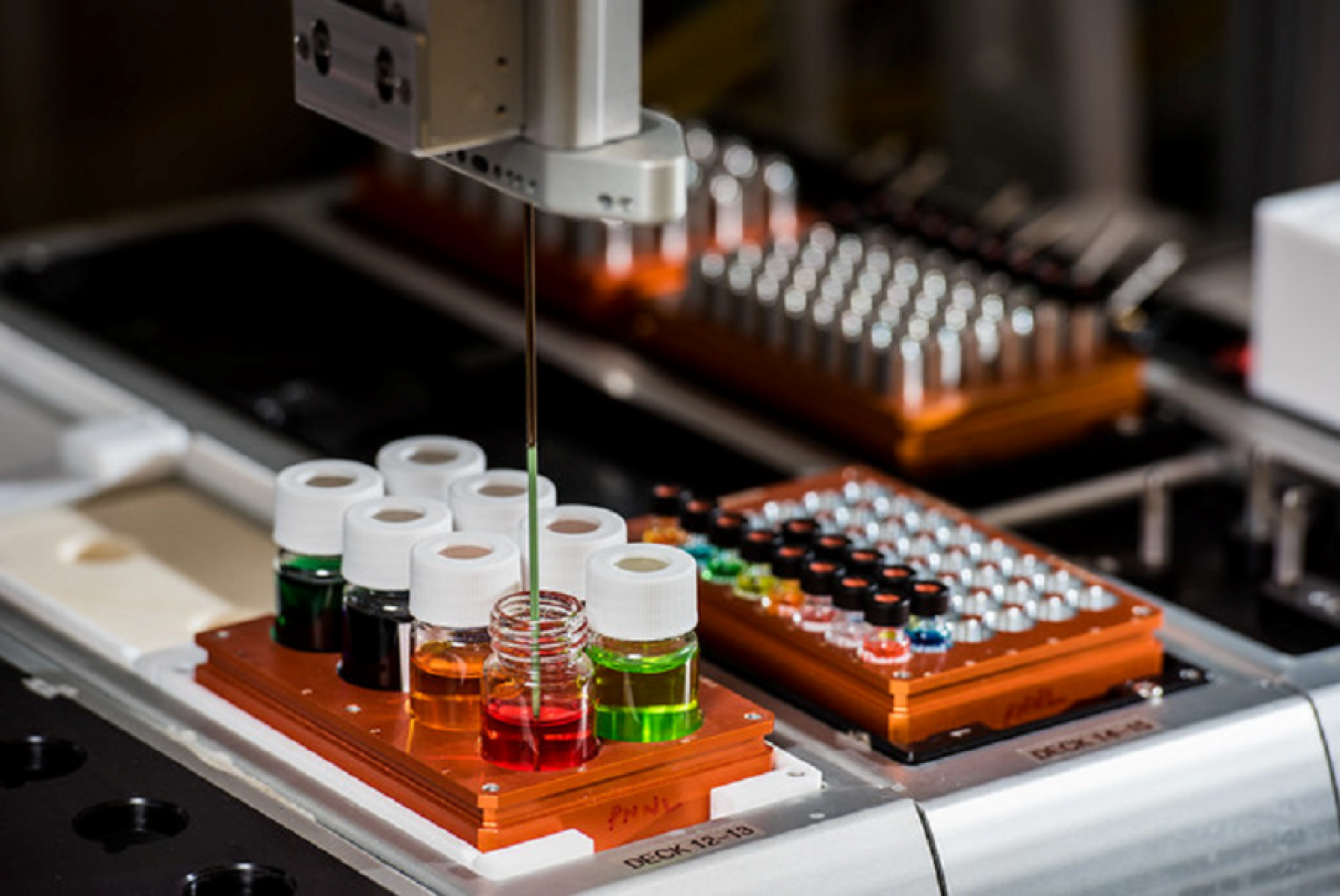PNNL robotic systems quickly carry out small-scale testing and routine laboratory tasks for bioenergy research and development.
September 4, 2019PNNL robotic systems quickly carry out small-scale testing and routine laboratory tasks for bioenergy research and development.
A rite of passage for graduate students in science includes hours in front of a computer, painstakingly transferring data from laboratory notebooks, instrument logs, and data-recorders. As full-fledged scientists, they can look forward to getting up in the middle of the night to keep their experiments on track. But for routine and repetitive small-scale laboratory tasks, robots are improving the researcher’s labor landscape—as well as their productivity.
Bioenergy Research Expedited Through Automated Preparation and Analysis
At the Pacific Northwest National Laboratory’s (PNNL’s) High Throughput Center (HTC), robotic systems prepare and analyze unique materials for bioenergy research applications, such as experiments with different biomass and wet waste feedstocks or catalysts for renewable fuels. The key to the HTC is its small-scale capabilities, which allow multiple experiments to run in parallel with robotic support.
These automated capabilities are the result of years of investments from the U.S. Department of Energy’s Bioenergy Technologies Office. During this time, the robotic systems have tackled a wide variety of experiments.
In one example involving the upgrade of synthesis gas into biofuels, robots ran five-day tests for each of the more than 1,000 catalyst compositions. This 24/7 experiment took just two years to identify the best candidates—instead of the 20 years that manual methods would have required.
Another example involved extracting high-value sugars from algae feedstock in preparation for hydrothermal liquefaction, a process used to convert wet biomass to bio-oil. To evaluate the extraction efficiencies for many different algae strains, standard analysis methods would need nearly 100 liters each of the scarce algae feedstocks. High-throughput testing required only 20 milliliters. To put this in perspective, 100 liters is about 26 gallons, while 20 milliliters is just 4 teaspoons.

PNNL’s High Throughput Center includes robotic systems that quickly and accurately perform repetitive physical tasks. Additional features include automated material screening and advanced analytics with data visualization. Photo courtesy of PNNL.
Efficient R&D Tools for the Job
As new bioenergy technologies move from the proof-of-concept stage to the discovery and screening stage, hundreds of materials and dozens of parameters could be viable options. Using robotic capabilities, researchers can perform up to 50 times more experiments over manual methods in practically the same amount of time.
In addition to delivering better statistical data, high-throughput techniques can eliminate issues such as sample-size limitations, difficult-to-trace reproducibility errors, and time constraints. HTC’s highly customizable experiment protocols provide flexibility for different experimental needs, and its dynamic databases record progress in real time and generate visuals to aid in discovery.
The HTC offers researchers three main features that can reduce costs and increase efficiencies during bioenergy experiments:
Automated Material Handling - At the HTC, customized robotic systems execute typical laboratory techniques modified for small-scale solid and liquid samples. The systems quickly and accurately perform repetitive physical tasks, such as:
- Placing viscous and slurry samples into small vials
- Capping and uncapping
- Sample filtering and washing
- Heating and stirring
- pH monitoring
- Sample dilutions.
Material Screening - Reactors are where a catalyst can shine, transforming feedstocks into more useful compounds. At the HTC, multi-batch and fixed-bed flow reactors expedite small-scale material testing. The reactors are constructed of borosilicate, quartz, Teflon, stainless steel, and Hastelloy. These materials accommodate different types of chemistry without causing catalyst degradation or side reactions.
The reactors can operate at up to 500°C and 3,000 pounds per square inch, with automated sampling of the flow system and on-line analysis of gas streams.
Data Analytics and Visualization - Integrated data collection and analysis empowers scientists to discover key links between material structures, experimental parameters, and reaction mechanisms.
Data from the various analytical methods are quickly, and often automatically, uploaded to custom project databases. These databases link to data analysis software designed to generate real-time data output with multivariable visualizations. The HTC routinely updates its data handling and software tools to meet changing project demands.
Power in Planning
PNNL's HTC capabilities hold wide-ranging potential for many bioenergy research areas that require rigorous sampling and experimentation. This is especially true for experiments with large data sets that benefit from robust experimental planning and design.
For more information about using the HTC for your experiment, email [email protected] or call her at 509.375-4529.

Dr. Asanga Padmaperuma
Dr. Asanga Padmaperuma is a Senior Research Chemist in the Energy Processes and Materials Division at Pacific Northwest National Laboratory. He serves as the Laboratory Relationship Manager for the Department of Energy's Bioenergy Technologies Office, which has oversight of research in sustainable use of marine, terrestrial, and waste biomass for fuels and chemicals via thermal, biological, and electrocatalytic conversion.

